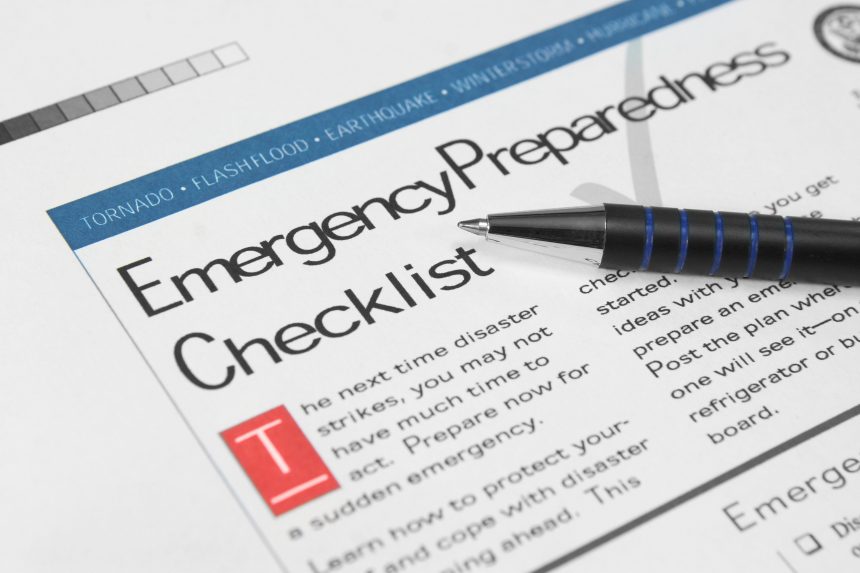Natural disasters can wreak havoc on communities, businesses, and households. Most people in disaster-prone regions know they should prepare, but very few actually do (Kapucu, 2008). It is imperative that every household is prepared for the worst-case scenario, especially if they live in a vulnerable area. This guide will serve as a reference for households in different areas of risk.
General Preparedness
There are certain principles that apply to all disasters and all recovery efforts. These are universal guidelines that will protect homes and families in the event of a catastrophe.
Disaster Kit
Most government websites advise citizens to prepare themselves and their families for 3 days without assistance. After the Washington Military Department ran a tsunami simulation called Cascadia Rising, they realized their original estimates were inaccurate. The government would be unable to reach certain groups for about 2 weeks.
Studies indicate that even after the devastating effects of Hurricane Katrina in 2005, residents of Louisiana were no better prepared for disaster (Hsu, 2005; Waugh, 2006).
It is imperative that citizens prepare themselves for at least 3 days without government assistance. If they are a resident of a high-risk zone, they should consider stockpiling more food and supplies.
FEMA recommends the following items for a disaster relief kit. Pack them in a large duffel bag or plastic containers:
- Water – one gallon of water per person per day for at least three days, for drinking and sanitation
- Food – at least a three-day supply of non-perishable food (keep in cool, dry place)
- Battery-powered or hand crank radio and a NOAA Weather Radio with tone alert
- Flashlight
- First aid kit
- Extra batteries
- Whistle to signal for help
- Dust mask to help filter contaminated air and plastic sheeting and duct tape to shelter-in-place
- Moist towelettes, garbage bags and plastic ties for personal sanitation
- Wrench or pliers to turn off utilities
- Manual can opener for food
- Local maps
- Cell phone with chargers and a backup battery
Other Considerations
Those with specific individual needs should consider additional supplies to pack. Parents of young children will need diapers or baby formula. Families with seniors in the house may need medication.
Citizens living in colder climates have other needs. Jackets, long pants, mittens, caps, thermal sleeping bags, hand warmers, a fire starter, and rugged shoes are all useful items to pack.
It is impossible to know when disaster will strike. Every citizen should have access to emergency relief materials at home, in a vehicle, and at work.
Disaster Plan
A WirthlinWorldwide (2004) poll found that only 22 percent of American households have received specific information and/or training on emergency preparation within the last 12 months.
Coming up with a disaster plan can save precious minutes in situations where time is of the essence. Every family should have a plan to address the following:
- How will family members receive emergency alerts and stay informed?
- Who will shut off the utilities?
- Who will fetch the emergency kit(s)?
- What is a meeting place if family members are separated?
- How will the family evacuate (including pets, people with disabilities, and senior citizens)?
- What are the evacuation routes?
- How will everyone find shelter?
- How will everyone communicate with each other?
- What are the dietary and medical needs to be addressed?
A primary consideration should be the protection of valuables. A safe can be swept away in a flood, hurricane, or tornado. A safety deposit box is the most secure option for storage.
Here is a list of items to place in a safety deposit box:
- House deed and mortgage papers
- Marriage certificate
- Birth certificates of all family members
- Social security cards of all family members
- Vehicle registrations
- Copies of driver’s licenses
- Passports
- Priceless momentos
Scan all documents and upload them to a cloud storage service for easy access.
Blizzards and Ice Storms
Though blizzards can bring a city to a halt for days at a time, they are forecasted in advance and allow residents to prepare.
Sidewalks and Driveways
Buy buckets of salt and coarse sand. Store them indoors so the sand doesn’t freeze. Before the storm hits, put a layer of salt down on walkways and exits. The salt will help melt any snow and ice buildup. When walkways must be cleared after the storm is over, the job will be much easier.
Spread a generous amount of sand over ice patches on walking paths and driveways. This will increase traction for both vehicles and pedestrians.
Snow Removal
If there is a snow blower in the house, buy extra gas for it before the storm hits. Turn it on to check if it’s working. Have spare parts on hand and store the blower in a dry place.
Without a blower, a shovel is the only viable alternative. Check that it is in good condition and buy a new one if it looks rough.
Drainage
Ice buildup on the eaves of a roof is called an ice dam. A simple way to prevent ice dams is by clearing debris out a home’s drainage system. Make sure gutters are clean, or water will back up and freeze on the roof.
Check the sump pump before the storm hits. Pouring a few gallons of water around it should determine whether it’s working or not. Have spare parts on hand in case it breaks.
Water Storage
As with any disaster, water storage is vital. In a blizzard, however, it’s important to flush a home’s pipes periodically to avoid freezing. Fill up several buckets of water to flush toilets and drains. Fill up the bathtub for extra water storage.
Flooding
Flooding is one of the most common natural disasters that can affect almost any citizen. Water flows fast and storm surges are extremely dangerous.
Evacuate
FEMA suggests immediate evacuation in the event of a flood. Residents can easily be trapped by flowing water and get cut off from emergency aid. Follow evacuation routes to avoid flood-related injuries and deaths.
Don’t allow small children to cross flood waters. Use a different route if the water reaches above the ankle. Head towards higher ground.
Elevate and Waterproof
To protect property, FEMA suggests elevating all critical infrastructure above ground level. This means electrical panels, switches, sockets, wiring, appliances, and heating systems should be raised to avoid contact with water.
Anchor any fuel tanks to the floor or wall to prevent them from floating up and leaking fuel.
As with blizzards, proper drainage is paramount. Check the sump pump and waterproofing measures in the basement. A battery-powered pump is a must-have in an emergency. Clear debris from the gutters to allow proper drainage. Replace a damaged roof as soon as possible to avoid leaks.
Search for any cracks in the home’s foundation and seal them with mortar and caulk. Only use materials that will expand in the crevice to avoid additional cracking.
Hurricanes
Hurricanes won’t affect every American, but those living on the coast (especially in the Gulf of Mexico) should always be prepared for one. Though they can be forecasted, they can also strengthen in a matter of hours and do immeasurable damage to communities in their paths.
Boarding Windows
Before the storm hits, buy sheets of plywood. To protect a home, cut the plywood to size and store it in a cool, dry place. These can be affixed to the home’s exterior windows and protect everyone inside the house. Hurricane-force winds can throw dangerous debris around. Sign posts and tree branches can be ripped away and shatter a home’s windows.
Cleaning the Yard
First, remove any items from the yard that could be blown away by the winds. This includes decorative pieces and anything that isn’t anchored into the ground.
Replacing gravel with mulch will offer more protection. The wind can blow the stones through windows and even cause damage to a neighbor’s house. Mulch will be harmless.
Cut off any dead branches from the trees in the yard. Don’t leave the branches outside for garbage collection. If the waste management company doesn’t take the branches, they’ll pose a risk to the home. Dispose of them in a dump or wood chipper instead.
Power Outages
In a high-category hurricane, power outages are almost guaranteed. Prepare for a few days without power for smaller storms. For larger ones, prepare for at least a week of outages.
Store clean drinking water in large jugs. The EPA has a great guide for purifying water in storage. Keep the water in the house and in a safe place. Fill up bathtubs, sinks, and other containers with water to flush toilets with. Just be sure to properly label the drinking water.
Safe Rooms
In the worst hurricanes, entire communities are torn to the ground. Many homes are entirely destroyed. If there is a basement in the house, it can be used as a safe location to wait out the storm.
If there is no basement and evacuation is no longer an option, find an interior room on the lowest floor. The safest place for a family will usually be a closet or bathroom.
Tornadoes
Tornadoes can be devastating not only for their destructive winds, but for their speed as well. They are hard to forecast and predict. A family may only have a couple minutes to take shelter, so it’s important that plans and preparations are made long before a tornado touches down.
Take Shelter
The most critical part of tornado preparation is forming a plan. Make sure family members know where to go in the midst of a tornado warning. Ensure all food, water, and supplies are in that location.
Every citizen should know what tornado alerts look and sound like. If a tornado siren is installed in the area, becoming familiar with the meaning of each sound can save lives. Indoors, a battery-powered or hand crank NOAA radio will keep families informed of any weather updates. Some models will turn on like a smoke detector and wake families up in the case of a tornado warning.
Just like during a hurricane, families should either move to a basement or an interior room on the lowest floor of the house. This will protect family members from falling debris and shattered glass. Tornadoes can arrive a few at a time, so always monitor a radio for the all-clear before leaving shelter.
Earthquakes
Certain areas like California and Alaska are at a much higher risk for earthquakes, but they can happen anywhere. Unlike tornadoes, they offer no warning and cannot be forecasted. Citizens must be prepared for an earthquake to strike at any time.
Prepare the House
Start earthquake preparations by fastening any large furniture to the walls and anchoring it to the floor. Wardrobes, grandfather clocks, bookcases, and free-standing shelves are examples of objects that could cause serious harm in an earthquake. Make sure there are no heavy objects stored in high places that could injure family members standing below.
Drop, Cover, and Hold On
In the event of an earthquake, family members should drop to the floor and find the closest cover from falling debris. Hold on until the shaking stops. When it does, take stock of any injuries and prepare for aftershocks.
Stay away from any slopes. There is a high chance of avalanches and landslides after earthquakes. Pay attention to downed power lines, trees, and other dangerous debris. If a family resides in an area with high risk for tsunamis, move inland and to higher ground as soon as possible.
As with any disaster, monitor emergency alerts carefully to stay updated on the situation.
Droughts
Areas in drought are prone to wildfires that can cover thousands of acres of land in a matter of hours. It is also important to save as much water as possible. Maintaining a home during a drought takes extra work, but those extra measures could save thousands of gallons of water per year.
Water Conservation
FEMA says residents in areas of drought should take the following measures to save water:
- Never pour water down the drain when there may be another use for it. For example, use it to water indoor plants or a garden.
- Repair dripping faucets by replacing washers. One drop per second wastes 2,700 gallons of water per year.
- Check all plumbing for leaks and have any leaks repaired by a plumber.
- Retrofit all household faucets by installing aerators with flow restrictors.
- Install an instant hot water heater on the sink.
- Insulate water pipes to reduce heat loss and prevent them from breaking.
- Install a water-softening system only when the minerals in the water would damage pipes. Turn the softener off while on vacation.
- Choose appliances that are more energy and water efficient.
Instead of sprinklers, consider a drip irrigation system that conserves water. For water conservation tips, visit FEMA’s website.
Fire Suppression
There are a few things families can do to lower the risk a wildfire poses.
First, clear all gutters of debris. This is point is vital to protecting a home. If a burning tree branch or other debris falls into a gutter blocked with dry leaves and twigs, the roof will easily catch fire, too.
Next, create a fire break around the property by removing any dead wood, fallen trees, or other flammable items. The further away flammable materials are from the home, the better.
If a fire is approaching the house, turn off all gas lines immediately. Cover all vents and windows with anything from duct tape to plywood. Set sprinklers up on the roof to keep the surface wet. Most importantly, the family should have all belongings packed into a car for evacuation at a moment’s notice.
Insurance
Insurance is a major factor in planning for any disaster as well. The experts suggest a thorough read of your policy to cover all contingencies (Pichaske, 2018).
Most policies do not cover flood and earthquake damage. Many policies have loopholes written into the fine print. Families should make sure their coverage is complete.
In coastal areas with high-risk of flooding, insurance premiums will be higher. For most homes, the danger posed by flooding justifies the more expensive premium. The same rule can be applied to high-risk areas for tornadoes, fires, and hurricanes.
Read each policy carefully. If the policy does not include the full amount of coverage, other companies will provide supplemental insurance to account for the gap.
Final Thoughts
Natural disasters can strike anywhere and at any time. Some of them can be forecasted, predicted, and prepared for days in advance. Others occur within a split second. No matter which type of disaster a family’s home is prone to, preparedness and planning are the best forms of protection.
Works Cited
Hsu, S.S. (2005), “Storms had little impact on preparedness”, The Washington Post, November 15.
Kapucu, N. (2008). Culture of preparedness: Household disaster preparedness.Disaster Prevention and Management, 17(4), 526–535. doi:http://dx.doi.org.ezproxy.net.ucf.edu/10.1108/09653560810901773
Pichaske, P. (2018). How to prepare your home or business for disasters. Rochester Business Journal, 34(37), 13. Retrieved from https://login.ezproxy.net.ucf.edu/login?url=https://search-proquest-com.ezproxy.net.ucf.edu/docview/2160693570?accountid=10003
Waugh, W.L. Jr (Ed.) (2006), “Shelter from the storm: repairing the national emergency management system after Hurricane Katrina”, The Annals of the American Academy of Political and Social Science, No. 604, special issue, March.
WirthlinWorldwide (2004), Attitudes and Behaviors toward Disaster Preparedness, prepared for the American Red Cross, WirthlinWorldwide, Reston, VA.
Please see our infographic below for this article summary.







